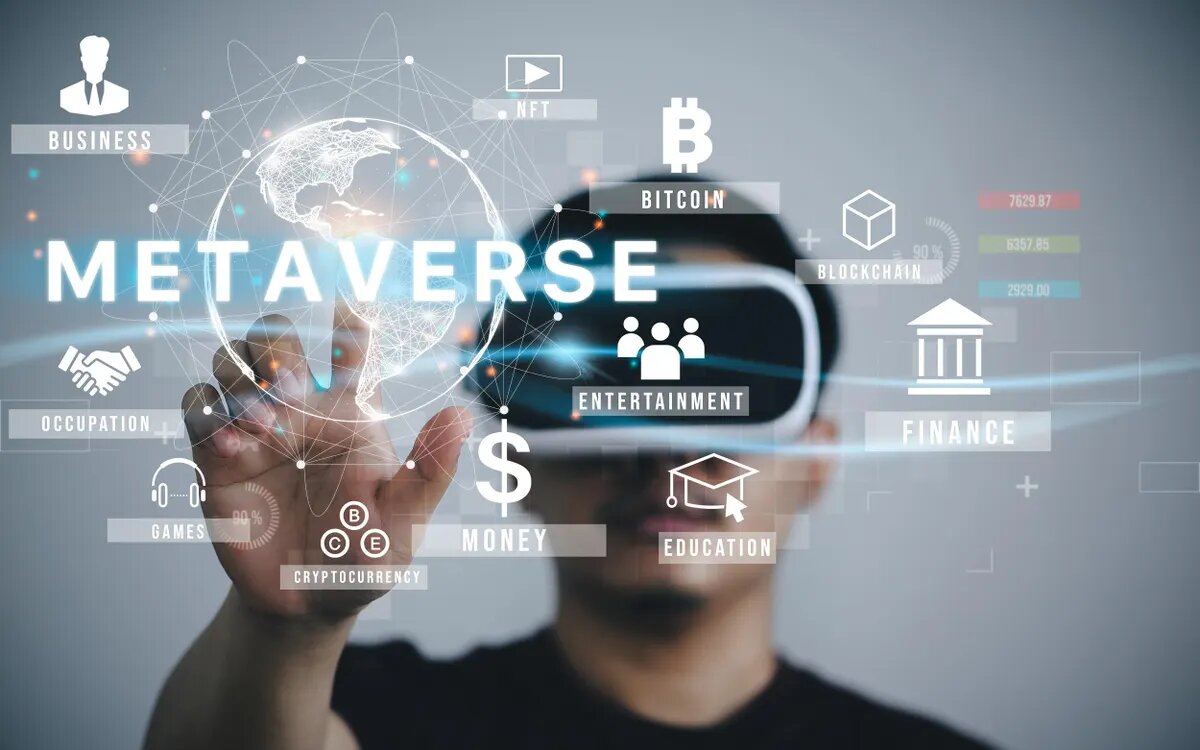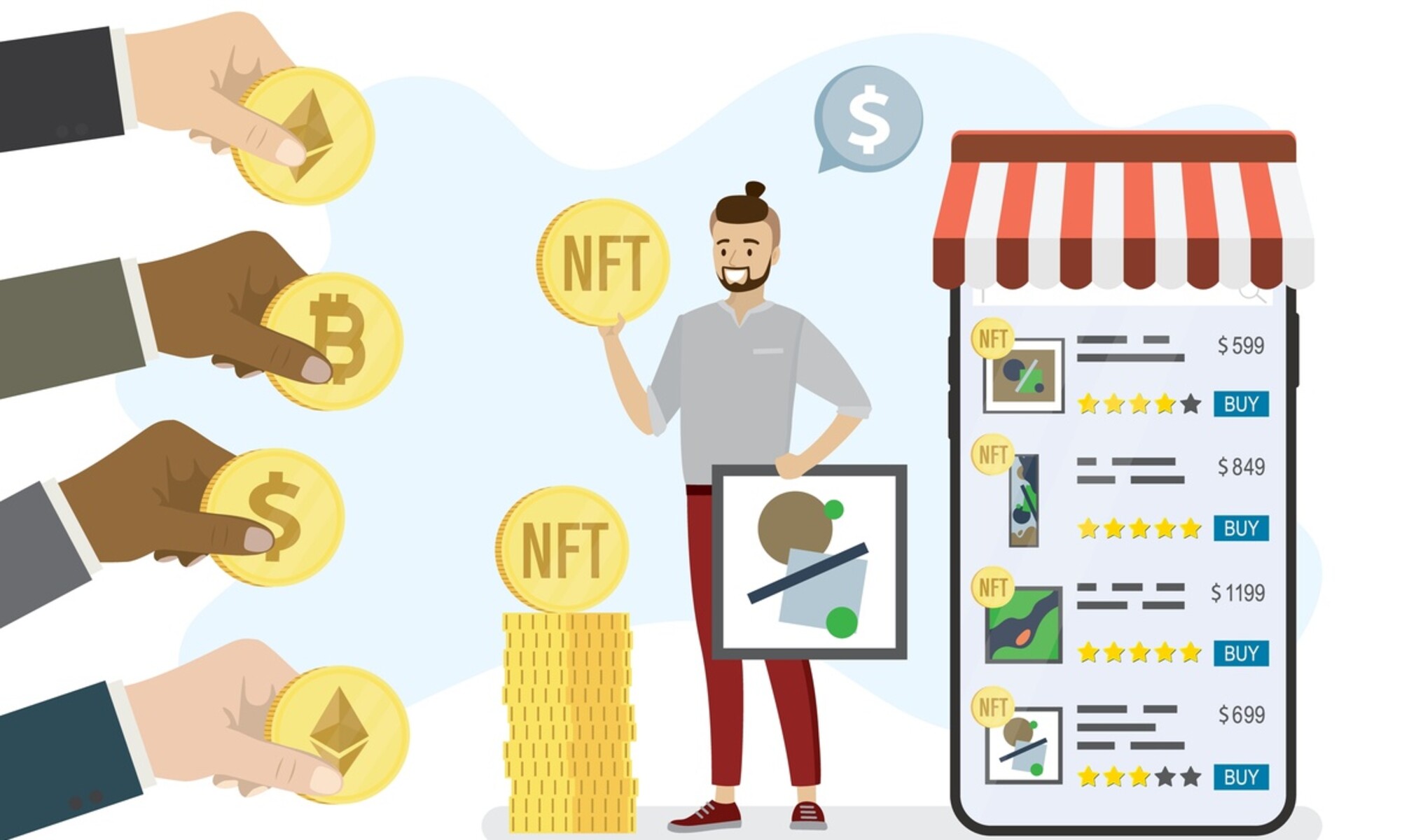Introduction
Welcome to the world of metaverse crypto, where virtual reality and blockchain technology converge to create exciting opportunities and possibilities. In recent years, metaverse crypto has gained significant attention as a promising sector with immense potential for growth and innovation. This article will provide an introduction to metaverse crypto, exploring what it is, how it works, its key features, benefits, potential use cases, as well as risks and limitations.
Metaverse crypto refers to digital assets and currencies that are native to virtual worlds or metaverses. A metaverse is a virtual reality space where users can interact with each other and the environment in real-time, often through the use of avatars. These virtual worlds are built on blockchain technology, which ensures security, transparency, and immutability.
At its core, metaverse crypto aims to enable users to own and trade virtual assets, such as virtual real estate, virtual goods, and even virtual identities, utilizing blockchain-powered tokens. These tokens, also known as non-fungible tokens (NFTs) or virtual assets, can represent unique items or properties within the metaverse. They provide proof of ownership and can be bought, sold, or traded on decentralized marketplaces.
The metaverse crypto ecosystem consists of decentralized virtual worlds, blockchain networks, smart contracts, and digital wallets. These elements work together to facilitate the creation, exchange, and ownership of virtual assets. As the metaverse continues to gain popularity, metaverse crypto has the potential to revolutionize industries such as gaming, art, entertainment, and even social media.
One of the key drivers behind the rise of metaverse crypto is the concept of digital scarcity. In the metaverse, virtual assets can have limited supply, making them valuable and sought after. This scarcity is enforced through the use of blockchain technology, which ensures the authenticity and uniqueness of each virtual asset. As a result, collectors, investors, and enthusiasts are drawn to metaverse crypto as a new frontier for acquiring and trading scarce digital goods.
Moreover, metaverse crypto offers new monetization opportunities for creators and developers. Artists can digitize their artworks and sell them as NFTs, allowing them to reach a global audience and receive direct compensation for their work. Game developers can create in-game items and land that players can purchase and trade, generating revenue for both the creators and the platform.
In the next sections of this article, we will delve deeper into the inner workings of metaverse crypto, explore its key features, examine its benefits, and discuss its potential use cases.
What is Metaverse Crypto?
Metaverse crypto refers to digital assets and currencies that are native to virtual worlds or metaverses. It combines the concept of the metaverse, a virtual reality space, with blockchain technology, creating a decentralized ecosystem for owning, trading, and interacting with virtual assets.
In simple terms, the metaverse is a digital universe where users can immerse themselves in virtual environments, interacting with other users, objects, and experiences. It is often accessed through virtual reality headsets or other devices that provide an immersive experience. Within the metaverse, users can explore and engage with various virtual worlds, each with its unique characteristics and offerings.
The key element that sets metaverse crypto apart is the integration of blockchain technology. Blockchain technology provides a decentralized, secure, and transparent infrastructure for managing and trading digital assets. It ensures that virtual assets within the metaverse are scarce, verifiable, and can be securely owned and transferred.
One of the prominent features of metaverse crypto is the use of non-fungible tokens (NFTs). NFTs are unique digital tokens that represent ownership of a specific virtual asset, such as virtual real estate, digital art, or virtual items. Each NFT contains metadata that provides information about the asset it represents, including its authenticity, provenance, and ownership history.
NFTs are built on blockchain networks, typically using Ethereum’s ERC-721 or ERC-1155 token standards. The use of blockchain ensures that each NFT is irreplaceable and cannot be duplicated or forged. This enables creators and users to establish verifiable ownership and provenance of virtual assets within the metaverse.
Metaverse crypto also encompasses the use of virtual currencies and tokens. These currencies, often referred to as metaverse tokens, can be used as a medium of exchange within the virtual world. Users may earn metaverse tokens through activities such as completing tasks, participating in events, or creating valuable content. These tokens can then be used to purchase virtual assets or services within the metaverse ecosystem.
The metaverse crypto ecosystem also includes decentralized marketplaces where users can buy, sell, and trade virtual assets. These marketplaces leverage blockchain technology to create transparent and secure platforms for transacting virtual assets. Users can list their assets, set prices, and engage in peer-to-peer transactions, often with minimal fees and intermediaries.
Overall, metaverse crypto represents a merging of virtual reality and blockchain technology, opening up a new world of possibilities for digital ownership, expression, and interaction. It offers a decentralized, secure, and immersive environment where users can explore, trade, and create value from virtual assets. As the metaverse continues to evolve and gain traction, the importance and potential of metaverse crypto are set to grow.
How Does Metaverse Crypto Work?
To understand how metaverse crypto works, let’s break it down into three key components: virtual worlds, blockchain technology, and virtual assets.
Virtual Worlds: Metaverse crypto operates within virtual worlds, which are immersive digital environments where users can interact with each other and the virtual environment. These worlds are built using virtual reality technology that provides a realistic and interactive experience. Users can navigate through these virtual worlds, create avatars, and engage in various activities such as exploration, socialization, and gameplay.
Blockchain Technology: Blockchain technology serves as the foundation for metaverse crypto. It provides a decentralized and secure infrastructure for managing digital assets, transactions, and ownership records. Within the metaverse, blockchain technology ensures that virtual assets are scarce, verifiable, and can be securely owned and transferred. It achieves this through the use of smart contracts, which are self-executing contracts that automatically facilitate and enforce the terms of agreements between parties. Smart contracts ensure that ownership of virtual assets is transparent and immutable.
Virtual Assets: Virtual assets are the key elements of metaverse crypto. These assets can take various forms, including virtual real estate, digital art, virtual items, and even virtual identities. Each virtual asset is represented by a unique non-fungible token (NFT), which is a digital token that represents ownership of a specific asset. NFTs are created and stored on the blockchain, ensuring that each asset is unique, verifiable, and cannot be duplicated or forged.
When a user wants to participate in the metaverse crypto ecosystem, they typically start by creating an account and obtaining a digital wallet. This wallet is used to store their virtual assets, such as NFTs and metaverse tokens. The wallet is secured using private keys, which allow the user to access and manage their assets.
Users can acquire virtual assets in different ways. They can purchase virtual assets from other users or from decentralized marketplaces within the metaverse. Transactions are executed using the native metaverse tokens or other cryptocurrencies accepted within the metaverse. Once the transaction is completed, the ownership of the virtual asset is transferred to the buyer’s wallet, recorded on the blockchain.
Within the metaverse, users can interact with their virtual assets in various ways. They can display their virtual real estate, showcase their digital art, or use virtual items within gameplay. Additionally, users can trade their virtual assets with other users, either through direct peer-to-peer transactions or through decentralized marketplaces.
Decentralized marketplaces play a crucial role in the metaverse crypto ecosystem. These marketplaces provide a platform for users to buy, sell, and trade virtual assets. They leverage blockchain technology to ensure transparency, security, and trust in the transactions. Users can list their assets on the marketplace, set prices, and engage in negotiations with potential buyers. Once a transaction is agreed upon, the ownership of the virtual asset is transferred on the blockchain, and the corresponding payment is processed.
Overall, metaverse crypto works by combining virtual worlds, blockchain technology, and virtual assets to create a decentralized ecosystem for owning, trading, and interacting with digital assets. Its innovative approach offers new possibilities for digital ownership and expression within immersive virtual environments.
Key Features of Metaverse Crypto
Metaverse crypto comes with several key features that set it apart from traditional digital assets and currencies. These features contribute to the unique and transformative nature of the metaverse crypto ecosystem. Let’s explore some of these key features:
- Ownership and Authenticity: One of the fundamental features of metaverse crypto is the ability to establish ownership and authenticity of virtual assets. Each virtual asset is represented by a non-fungible token (NFT) that contains metadata, including information about its provenance, ownership history, and other relevant details. This ensures that the ownership of virtual assets is transparent and verifiable, providing a sense of ownership and value to users.
- Digital Scarcity: Metaverse crypto introduces the concept of digital scarcity, making virtual assets valuable and sought after. Through the use of blockchain technology, each virtual asset is unique and limited in supply. This scarcity is achieved by creating NFTs that represent specific virtual assets, ensuring that they cannot be duplicated or forged. The element of digital scarcity adds a level of collectability and rarity to metaverse crypto, attracting collectors and enthusiasts.
- Decentralization: Decentralization is a core principle of metaverse crypto. The use of blockchain technology ensures that the metaverse operates in a decentralized manner, with no central authority controlling the virtual assets or transactions. This eliminates the need for intermediaries or trusted third parties, allowing for peer-to-peer interactions and transactions with increased security and transparency.
- Interoperability: Interoperability is another essential feature of metaverse crypto. Virtual assets created within one metaverse or virtual world can potentially be used or transferred to another metaverse or platform. This allows for a seamless flow of assets and interactions between different virtual worlds, creating a more connected and dynamic metaverse ecosystem.
- Monetization Opportunities: Metaverse crypto opens up new avenues for creators and developers to monetize their digital creations or contributions. Artists can tokenize their artworks and sell them as NFTs, receiving direct compensation and royalties when their creations are traded or used. Game developers can create in-game items or virtual land, enabling players to purchase and trade these assets, creating a new revenue stream for both the developers and the platform.
These key features of metaverse crypto contribute to the growing popularity and adoption of this emerging sector. They revolutionize how we perceive ownership, authenticity, and value in the digital realm, offering new possibilities for creators, collectors, and users within the metaverse ecosystem.
Benefits of Metaverse Crypto
The rise of metaverse crypto brings forth a multitude of benefits that impact various stakeholders within the metaverse ecosystem. These benefits encompass aspects of ownership, creativity, interoperability, economic opportunities, and beyond. Let’s explore some of the key benefits of metaverse crypto:
- Digital Asset Ownership: Metaverse crypto enables individuals to truly own their virtual assets. By utilizing blockchain technology and non-fungible tokens (NFTs), users can have provable ownership of virtual real estate, virtual goods, and other digital assets within the metaverse. This establishes a sense of ownership and control over their digital possessions, allowing users to freely trade or monetize their assets without the risk of them being taken away or counterfeited.
- Creative Expression and Monetization: Metaverse crypto offers creators and artists new avenues to express their creativity and monetize their digital creations. Artists can tokenize their artworks or designs as NFTs, giving them the opportunity to reach a global audience and directly sell their work. This allows artists to have greater control over their intellectual property and receive fair compensation for their creations, revolutionizing traditional art markets.
- Economic Opportunities: Metaverse crypto presents economic opportunities for both individuals and businesses. Users can earn metaverse tokens or virtual assets by participating in activities within the metaverse, such as gameplay, content creation, or virtual events. This allows individuals to earn income or rewards based on their participation and contribution to the metaverse ecosystem. Additionally, businesses can leverage metaverse crypto to create unique and engaging experiences, attracting a global audience and generating revenue through the sale of virtual goods or services.
- Interoperability: Metaverse crypto promotes interoperability between different virtual worlds and platforms. Virtual assets created within one metaverse can potentially be used or transferred to another, allowing for a seamless experience across multiple virtual environments. This interoperability enhances user engagement and promotes a broader sense of community within the metaverse.
- Inclusion and Accessibility: Metaverse crypto has the potential to democratize access to virtual worlds. With the use of blockchain technology and decentralized marketplaces, individuals from anywhere in the world can participate in the metaverse ecosystem. This opens up opportunities for individuals who may not have had access to traditional financial systems or creative outlets, fostering inclusivity and providing a level playing field for all participants.
Overall, metaverse crypto brings numerous benefits to users, creators, and businesses. It empowers individuals with true ownership and control over their digital assets, provides economic opportunities, fosters creativity, and promotes inclusivity within the metaverse ecosystem. As the metaverse continues to evolve, the potential for further benefits and innovation within metaverse crypto is boundless.
Potential Use Cases for Metaverse Crypto
The integration of metaverse crypto into virtual worlds opens up a wide range of potential use cases across various industries. The unique features of metaverse crypto, such as digital ownership, authenticity, and interoperability, present opportunities for innovation and disruption. Let’s explore some of the potential use cases for metaverse crypto:
- Gaming: Gaming is one of the most prominent use cases for metaverse crypto. Virtual assets, such as in-game items, weapons, or characters, can be tokenized as NFTs, allowing players to own, trade, and sell these assets. Metaverse crypto also enables developers to create decentralized economies within games, where players can earn in-game currency or virtual assets that hold real-world value.
- Digital Art: The art world has embraced metaverse crypto, providing artists with new opportunities to showcase and monetize their digital creations. Artists can tokenize their artworks as NFTs, allowing them to retain ownership, prove authenticity, and directly sell their art to collectors. This bypasses traditional gatekeepers and expands the reach and potential revenue for artists.
- Virtual Real Estate: Metaverse crypto enables the ownership and trading of virtual real estate within virtual worlds. Users can purchase, sell, or lease virtual land or properties using blockchain technology. This opens up opportunities for virtual real estate development, where users can create and monetize virtual spaces for events, businesses, or social interactions.
- Fashion and Virtual Goods: Metaverse crypto can revolutionize the fashion industry by introducing virtual fashion and accessories that can be bought, sold, and worn in virtual worlds. Users can express their style and individuality by owning unique virtual clothing or accessories as NFTs, creating a new market for digital fashion designers and collectors.
- Virtual Events and Experiences: Metaverse crypto offers the potential to host and monetize virtual events and experiences. Users can attend concerts, conferences, or exhibitions within the metaverse, purchasing virtual tickets or access passes using metaverse tokens. This allows for a global audience and creates new revenue streams for event organizers and performers.
- Social Media and Networking: Metaverse crypto can redefine social media and networking by creating immersive and interactive virtual spaces where users can connect and engage. Users can personalize their virtual identities, own virtual avatars, and socialize with others in virtual environments. Metaverse crypto also introduces the potential for rewarding users for their contributions and interactions within the virtual social platforms.
These potential use cases represent just a glimpse of the possibilities that metaverse crypto offers. As the metaverse ecosystem continues to evolve, we can expect to see further innovation, integration, and adoption of metaverse crypto in various industries, enhancing user experiences and transforming traditional business models.
Risks and Limitations of Metaverse Crypto
While metaverse crypto has the potential to revolutionize industries and create groundbreaking opportunities, it is important to consider the associated risks and limitations. These factors can influence the development, adoption, and sustainability of metaverse crypto. Let’s explore some of the key risks and limitations:
- Volatility and Speculation: The value of virtual assets and cryptocurrencies can be highly volatile, leading to significant price fluctuations. This volatility can be influenced by market trends, investor sentiment, and regulatory developments. Speculation within the metaverse crypto market can lead to hype, bubbles, and potential financial losses for individuals who engage without proper understanding and risk assessment.
- Scams and Fraud: The decentralized and open nature of metaverse crypto can make it susceptible to scams and fraudulent activities. Users need to be cautious and verify the legitimacy of projects, virtual assets, and platforms before participating. The lack of regulation and oversight can create opportunities for fraudsters to exploit unsuspecting individuals.
- Technical Challenges: Metaverse crypto relies heavily on blockchain technology, which has its own technical limitations. Scalability issues, high transaction fees, and long confirmation times can hinder the smooth operation of metaverse ecosystems. Additionally, the reliance on digital wallets and private keys introduces cybersecurity risks, as users must protect their access credentials from theft or hacking attempts.
- Legal and Regulatory Uncertainty: Metaverse crypto operates at the intersection of virtual worlds, digital assets, and financial transactions, creating a complex legal and regulatory landscape. The lack of clear regulations and varying approaches globally can pose challenges for the adoption and integration of metaverse crypto. Regulatory changes or crackdowns on virtual assets can impact the viability and legality of certain metaverse crypto activities.
- Environmental Impact: The energy consumption of blockchain networks used in metaverse crypto, such as Proof of Work (PoW) consensus algorithms, has raised concerns about the environmental impact. The computing power required for mining cryptocurrencies can lead to significant carbon emissions. As the metaverse industry grows, there is a need to explore and adopt more energy-efficient and sustainable blockchain solutions.
It is crucial for individuals and businesses to conduct thorough research, exercise caution, and understand the risks associated with metaverse crypto before engaging in any transactions or investments. Additionally, industry collaboration, regulatory clarity, and technological advancements are needed to address these risks and limitations, promoting safer and more sustainable development within the metaverse crypto ecosystem.
Conclusion
Metaverse crypto represents the exciting union of virtual reality and blockchain technology, opening up a world of possibilities for digital ownership, creativity, and interaction. It has the potential to revolutionize industries such as gaming, art, fashion, and social networking, offering unique features like digital ownership, authenticity, and interoperability.
By leveraging blockchain technology and non-fungible tokens (NFTs), metaverse crypto enables individuals to truly own and trade virtual assets within virtual worlds. It empowers creators to monetize their digital creations, while also providing economic opportunities for users through activities and contributions within the metaverse.
However, metaverse crypto is not without its risks and limitations. Volatility, scams, technical challenges, legal uncertainties, and environmental impact pose challenges to the widespread adoption and sustainability of metaverse crypto. It is crucial for users, businesses, and regulators to navigate these risks while fostering innovation and responsible practices.
As the metaverse ecosystem evolves, industry collaboration, regulatory clarity, and technological advancements will play a vital role in shaping the future of metaverse crypto. It is an exciting time of exploration and innovation, where the possibilities are limitless.
The potential use cases and benefits of metaverse crypto are enticing, offering new ways to create, connect, and transact within virtual worlds. As the metaverse continues to gain popularity and mainstream recognition, the integration of metaverse crypto is set to transform the digital landscape and redefine how we perceive and interact with virtual assets.
Considering the promises and challenges of metaverse crypto, it will be fascinating to witness its growth and development in the coming years. By striking a balance between innovation, responsible practices, and user-centric design, metaverse crypto can truly unlock the full potential of the metaverse and reshape the future of digital experiences.

























